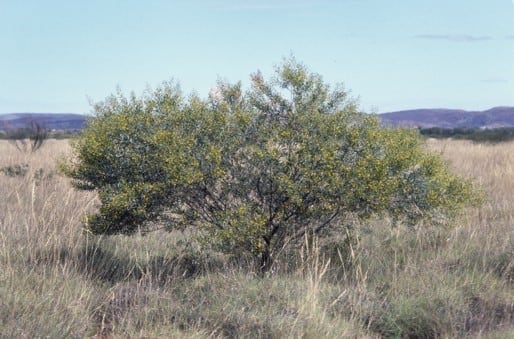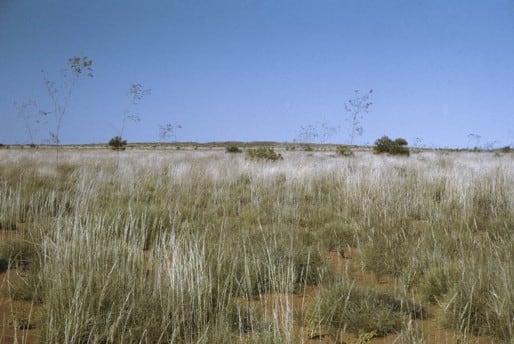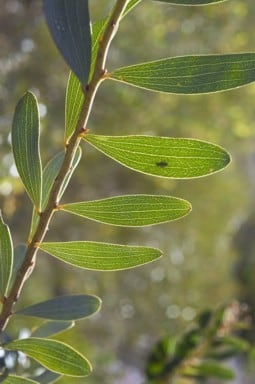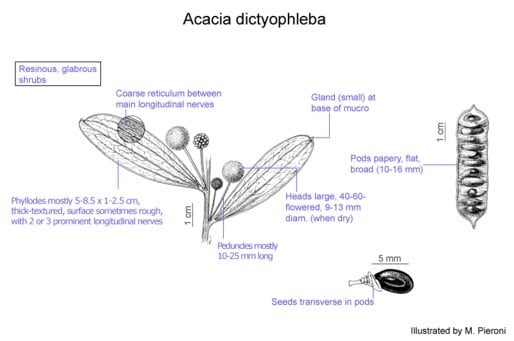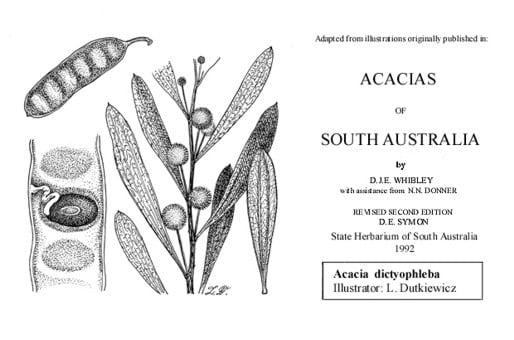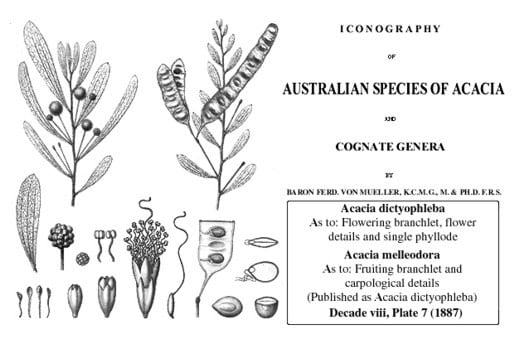Acacia dictyophleba F.Muell.
WATTLE
Acacias of Australia
Common Name
Waxy Wattle, Sandhill Wattle, Feather-veined Wattle
Family
Fabaceae
Distribution
Widespread in the N and central arid zone where it extends from the Pilbara region in W.A. eastwards through southern N.T. and north-eastern S.A. to south-west Qld; particularly common in the Simpson Desert.
Description
Shrub 1–4 m high, glabrous and resinous. Branchlets often sparsely tuberculate. Phyllodes oblanceolate, (4–) 5–8.5 cm long, (9–) 10–25 (–28) mm wide, l:w = 3–7 (–11), obtuse, mucronulate, thickly coriaceous, smooth or asperulate by small tubercles on nerves, dark green but soon aging grey-green or an attractive blue-grey, with resin sometimes drying white (especially over nerves); prominent longitudinal nerves 2 or 3, with secondary nerves forming a coarse, open reticulum; basal gland prominent, elongate, 1–3 mm long, with an obscure smaller gland at base of the minute apical point. Inflorescences simple, 1–3 per axil; peduncles 10–25 (–50) mm long, ebracteate at base; heads globular or obloid, 9–13 mm diam. when dry, densely 40–60-flowered, golden. Flowers 5-merous; sepals united almost to their apices. Pods stipitate, narrowly oblong, flat, raised over seeds alternately on each side, to 9 cm long, 1–1.6 cm wide, firmly chartaceous, often ±vernicose. Seeds transverse, c. 4 mm long, arillate.
Phenology
Flowers Mar.–Sept., main flush May–early July.
Habitat
Grows mainly in deep red or red-brown siliceous sand, on dunes or interdunal areas; sometimes found on shallow stony soils.
Specimens
W.A.: about 88 km NW of Wittenoom on the road to Roebourne, B.R.Maslin 5569 (BRI, NSW, PERTH). N.T.: 20 km NNW of Finke Settlement, D.E.Albrecht 5647 (BRI, DNA, PERTH). S.A.: edge of Simpson Desert, 8 miles [12.8 km] W of Purni Well, D.E.Symon 3277 (AD, K). Qld: Hammond Downs, near (E of) Windorah, S.T.Blake 12057 (BRI).
Notes
Acacia dictyophleba regenerates from seed after fire and also resprouts vigorously from the root stock; it is used extensively in mine site rehabilitation programs in the Pilbara, W.A. It is attractive shrub with horticultural potential on account of its large golden heads and often blue-grey foliage that is coated with a white bloom at certain times of the year. The Aboriginal use of A. dictyophleba in central Australia is discussed by P.Latz, Bushfires & Bushtucker 96 (1995) but it is probable that most of the information contained in this account refers to A. melleodora.
Acacia melleodora, A. jensenii and A. sabulosa may ultimately prove better placed as infraspecific taxa of A. dictyophleba. Acacia jensenii and A. sabulosa are most readily distinguished from both A. dictyophleba and A. melleodora by their generally more elongate and predominantly 1-nerved phyllodes. Acacia melleodora is especially close to A. dictyophleba but is usually recognised by its smaller flowers and flower heads and by its generally smaller, less coarsely nerved phyllodes. There are, however, some specimens from W.A. that appear to be intermediate for these characters (fide B.R.Maslin, J. Adelaide Bot. Gard. 2: 307 (1980)).
Some plants from the northern Gibson Desert and the Little Sandy Desert, W.A., are unusual and may represent a distinct taxon. They are spindly, single-stemmed shrubs 3–6 m tall with 2-nerved, rather large phyllodes (mostly 4–6 × 1–1.5 cm), similar to those found on A. dictyophleba. However, the phyllodes are not thickly coriaceous or coarsely nerved like that species and, furthermore, their heads are only 6–8 mm diam. when dry (smaller than those of A. dictyophleba, but within the range of A. melleodora). Principally on account of their distinctive growth habit, these plants were included by B.R.Maslin, Fl. Centr. Australia 132 (1981) under A. jensenii (e.g. 4.8 km W of Well 23, Canning Stock Route, N of Lake Disappointment, B.R.Maslin 2275, CANB, PERTH), but their 2-nerved phyllodes distinguishes them from that species. These spindly plants are favoured by Aborigines for making spears.
FOA Reference
Data derived from Flora of Australia Volumes 11A (2001), 11B (2001) and 12 (1998), products of ABRS, ©Commonwealth of Australia
Author
Edited by B.R.Maslin
B.R.Maslin
This identification key and fact sheets are available as a mobile application:
URL: https://apps.lucidcentral.org/wattle/
© Copyright 2018. All rights reserved.
